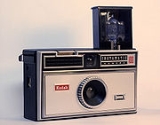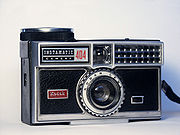
Instamatic
Encyclopedia


126 film
126 is the number given to a cartridge-based film format used in still photography. It was introduced by Kodak in 1963, and is associated mainly with low-end point-and-shoot cameras, particularly Kodak's own Instamatic series of cameras....
and 110
110 film
110 is a cartridge-based film format used in still photography. It was introduced by Kodak in 1972. 110 is a miniaturised version of Kodak's earlier 126 film format. Each frame is , with one registration hole....
camera
Camera
A camera is a device that records and stores images. These images may be still photographs or moving images such as videos or movies. The term camera comes from the camera obscura , an early mechanism for projecting images...
s made by Kodak beginning in 1963. The Instamatic was immensely successful, introducing a generation to low-cost photography
Photography
Photography is the art, science and practice of creating durable images by recording light or other electromagnetic radiation, either electronically by means of an image sensor or chemically by means of a light-sensitive material such as photographic film...
and spawning numerous imitators.
During its heyday, the range was so ubiquitous that the Instamatic name is still frequently used (erroneously) to refer to any inexpensive point-and-shoot camera. (It is also frequently used incorrectly to describe Kodak's line of instant-picture camera
Instant camera
The instant camera is a type of camera that generates a developed film image. The most popular types to use self-developing film were formerly made by Polaroid Corporation....
s.)
The Instamatic name was also used by Kodak on some Super 8
Super 8 mm film
Super 8 mm film is a motion picture film format released in 1965 by Eastman Kodak as an improvement of the older "Double" or "Regular" 8 mm home movie format....
-based home-cine cameras.
Early Instamatics
The first Instamatics went on sale early in 1963. They were the first cameras to utilize Kodak's new 126 format. The easy-load filmPhotographic film
Photographic film is a sheet of plastic coated with an emulsion containing light-sensitive silver halide salts with variable crystal sizes that determine the sensitivity, contrast and resolution of the film...
cartridge made the cameras very inexpensive to produce, as it provided the film backing plate and exposure counter itself and thus saved considerable design complexity and manufacturing cost for the cameras. A wide variety of print and slide film was sold by Kodak in the 126 format.
The lead designer for the Instamatic program was Dean M. Peterson
Dean M. Peterson
Dean McCormack Peterson was an American inventor, responsible for two of consumer photography’s largest revolutions: the Kodak Instamatic camera, introduced in 1963, and the panoply of “point-and-shoot” cameras introduced in the late 1970s...
, also later known for most of the innovations in the point-and-shoot camera revolution of the 1980s. The first Instamatic to be released was the Instamatic 50, which appeared in the UK
United Kingdom
The United Kingdom of Great Britain and Northern IrelandIn the United Kingdom and Dependencies, other languages have been officially recognised as legitimate autochthonous languages under the European Charter for Regional or Minority Languages...
in February 1963, about a month before the 100. The first model released in the US was the basic Instamatic 100. With fixed shutter speed, aperture and focus, it continued in the tradition of Kodak's earlier Brownie
Brownie (camera)
Brownie is the name of a long-running and extremely popular series of simple and inexpensive cameras made by Eastman Kodak. The Brownie popularized low-cost photography and introduced the concept of the snapshot. The first Brownie, introduced in February, 1900, was a very basic cardboard box camera...
cameras, providing a simple snapshot
Snapshot (photography)
A snapshot is popularly defined as a photograph that is "shot" spontaneously and quickly, most often without artistic or journalistic intent. Snapshots are commonly considered to be technically "imperfect" or amateurish—out of focus or poorly framed or composed...
camera anyone could use. It also featured a built-in flashgun
Flash (photography)
A flash is a device used in photography producing a flash of artificial light at a color temperature of about 5500 K to help illuminate a scene. A major purpose of a flash is to illuminate a dark scene. Other uses are capturing quickly moving objects or changing the quality of light...
for AG-1 "peanut" bulbs, a feature lacking in the 50.
The lineup was soon expanded to include a variety of models from the basic but popular 100/104 to the automatic exposure 800/804, which featured an aluminum chassis, rangefinder
Rangefinder
A rangefinder is a device that measures distance from the observer to a target, for the purposes of surveying, determining focus in photography, or accurately aiming a weapon. Some devices use active methods to measure ; others measure distance using trigonometry...
, selenium
Selenium
Selenium is a chemical element with atomic number 34, chemical symbol Se, and an atomic mass of 78.96. It is a nonmetal, whose properties are intermediate between those of adjacent chalcogen elements sulfur and tellurium...
light meter
Light meter
A light meter is a device used to measure the amount of light. In photography, a light meter is often used to determine the proper exposure for a photograph...
, and clockwork
Clockwork
A clockwork is the inner workings of either a mechanical clock or a device that operates in a similar fashion. Specifically, the term refers to a mechanical device utilizing a complex series of gears....
spring wind. (The 100/104 designation refers to the type of flash: models ending in 0 had a built-in flashgun, while those ending in 4 used flashcubes.) The top-of-the-line model was the Instamatic Reflex SLR, which was made in Germany
Germany
Germany , officially the Federal Republic of Germany , is a federal parliamentary republic in Europe. The country consists of 16 states while the capital and largest city is Berlin. Germany covers an area of 357,021 km2 and has a largely temperate seasonal climate...
and could accept a variety of Retina
Kodak Retina
Retina was the name of a long-running series of German-built Kodak cameras. Retinas were manufactured in Stuttgart by Nagel Camerawerk, which Kodak had acquired in 1931, and sold under the Kodak nameplate. Retinas were noted for their compact size, quality, and low cost compared to their...
S-mount lenses
Photographic lens
A camera lens is an optical lens or assembly of lenses used in conjunction with a camera body and mechanism to make images of objects either on photographic film or on other media capable of storing an image chemically or electronically.While in principle a simple convex lens will suffice, in...
.
Commercial success
The Instamatic was an instant success; more than 50 million Instamatic cameras were produced between 1963 and 1970. Kodak even gave away a considerable number in a joint promotion with Scott paper towels in the early 1970s in order to generate a large number of new photographers and stimulate lasting demand for its film business.Many other manufacturers attempted to capitalize on the popularity of the Instamatic with their own 126 cameras, including Canon
Canon Inc.
is a Japanese multinational corporation that specialises in the manufacture of imaging and optical products, including cameras, camcorders, photocopiers, steppers and computer printers. Its headquarters are located in Ōta, Tokyo, Japan.-Origins:...
, Olympus
Olympus Corporation
is a Japan-based manufacturer of optics and reprography products. Olympus was established on 12 October 1919, initially specializing in microscope and thermometer businesses. Its global headquarters are in Shinjuku, Tokyo, Japan, while its USA operations are based in Center Valley, Pennsylvania,...
, Minolta
Minolta
Minolta Co., Ltd. was a Japanese worldwide manufacturer of cameras, camera accessories, photocopiers, fax machines, and laser printers. Minolta was founded in Osaka, Japan, in 1928 as . It is perhaps best known for making the first integrated autofocus 35mm SLR camera system...
, Ricoh
Ricoh
or Ricoh, is a Japanese company that was established in 1936 on February 6th, as , a company in the RIKEN zaibatsu. Its headquarters is located in Ricoh Building in Chūō, Tokyo....
, Zeiss Ikon, and even Rollei
Rollei
Rollei is a German manufacturer of optical goods founded in 1920 by Paul Franke and Reinhold Heidecke in Braunschweig, Lower Saxony, and maker of the Rolleiflex and Rolleicord series of cameras...
. Some of these models were far more sophisticated and expensive than the Kodak cameras: the Rollei SL26, for instance, featured interchangeable lenses, TTL metering
Through-the-lens metering
Through-the-lens metering is a photographic term describing a feature of cameras capable of measuring light levels in a scene through their taking lenses, as opposed to a separate metering window...
, and a rangefinder, and retailed for $300.
A new series of Instamatics was introduced in 1970 to take advantage of the new Magicube flash technology. Magicubes used mechanically triggered pyrotechnic detonators for each bulb, an improvement over flashcubes in that the need for batteries was eliminated. Instamatics with Magicube sockets were denoted by an "X" in the model number (e.g. X-15 or 55X).
"Pocket Instamatic" (110-format)
In 1972, Kodak introduced the Pocket Instamatic series for its new 110 format. The 110 cartridge had the same easy-load design as the 126 format but was much smaller, allowing the cameras to be very compact (hence the "Pocket" designation). The top-of-the-line model was the Pocket Instamatic 60, which featured a stainless steelStainless steel
In metallurgy, stainless steel, also known as inox steel or inox from French "inoxydable", is defined as a steel alloy with a minimum of 10.5 or 11% chromium content by mass....
body, rangefinder, and automatic exposure. More than 25 million Pocket Instamatics were produced in under three years, and the 110 format remained popular into the 1990s. However the small negative size limited quality when using the film emulsion of the period, although in practise most prints were small so this was not as apparent until they were 'blown up' to a larger size.

